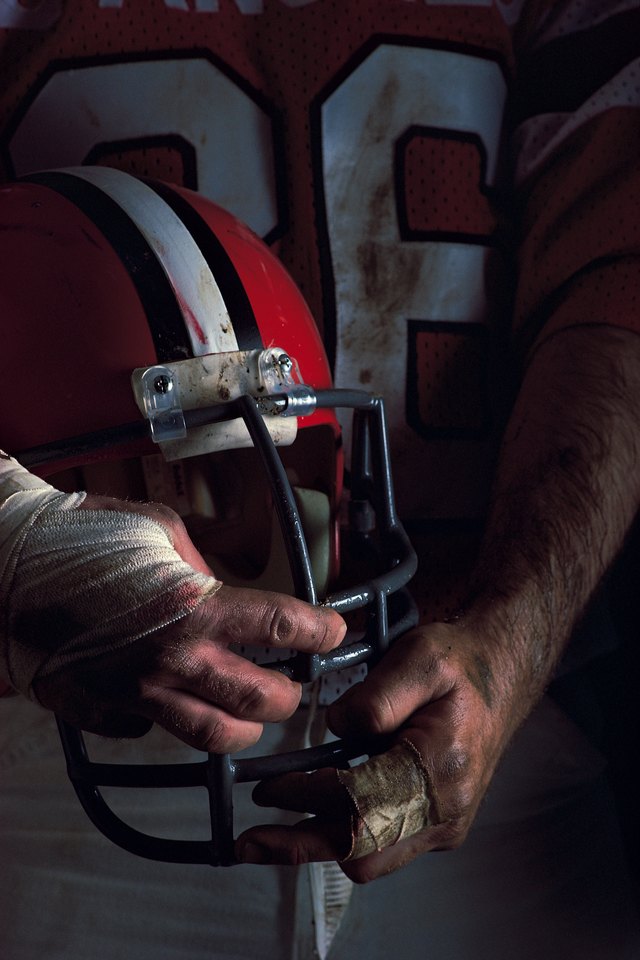How to Get Rid of Mold on Football Helmets & Pads

Unpacking the football gear after a long, hard season is a disheartening experience. After prying the bag out of the player's hands, the hapless parent or spouse has the dubious privilege of cleaning the smelly, bacteria-laden jersey, pants, pads and helmet. Because the gear hasn't been aired or hung to dry after use, it may have developed mold or mildew. While some items can soak in oxygen bleach and an enzyme detergent before being tossed into the washer, larger pieces of gear, such as shoulder pads and helmets, must be handled carefully to avoid damaging the foam padding and hard plastic exterior.
The Helmet
Remove any detachable parts, such as the cage, straps and foam padding, from the helmet.
Mix 1 scoop of oxygen bleach with 1 gallon of hot water. Add 2 tablespoons mild dishwashing liquid and stir to mix thoroughly.
Wipe the cage, straps and detached pads with the oxygen bleach solution, using a sponge or rag. Use a soft toothbrush to scrub off any dried-on dirt, mold or mildew. Rinse under the faucet with cool water and set aside to dry.
Dip a sponge into the oxygen bleach solution and squeeze out the excess liquid. Wipe the helmet, inside and out, to remove dirt, perspiration, blood stains and mold or mildew. Rinse the sponge in fresh water and repeat as necessary to clean the helmet.
Wet a soft toothbrush with water and then dip it into baking soda. Gently scrub the cracks and crevices in the helmet and between the pads to remove any lingering traces of mold and mildew.
Dip a clean sponge into warm water. Use the wet sponge to wipe the inside of the helmet, removing the baking soda.
Place the helmet in a warm location to dry. Avoid placing the helmet in direct sunlight; the UV rays may damage the interior foam pads.
Spray the interior of the helmet with a light coat of disinfectant to discourage any new mold or mildew from growing while it's in storage.
Cleaning the Foam Pads
Place 2 scoops of oxygen bleach and 3 to 4 tablespoons of mild dishwashing liquid in a deep laundry sink. Fill the sink half-full with hot water.
Place the larger pieces of gear, such as the shoulder or leg pads, into the sink. Swish the gear up and down in the water to completely cover it with the oxygen bleach solution.
Place a couple of wet towels on top of the gear to keep it submerged in the water. Allow the gear to soak for an hour.
Remove the wet towels from the sink. Using a sponge, wipe the gear to remove the dirt, blood, mold or mildew.
Allow the water to drain from the sink. Examine the gear for dirt, mold or mildew. Gently scrub all the cracks and crevices in the pads with a small soft brush or toothbrush to remove any lingering dirt, mold or mildew.
Rinse the gear thoroughly with fresh water. Sniff cautiously and if it still smells, add a cup of baking soda to the sink and refill with fresh water. Soak the gear for another hour in the baking soda solution to deodorize it.
Rinse the gear with fresh water and hang it over the sink or outside, out of the sun, to dry.
Spray all of the gear with a light coat of disinfectant. Allow the gear to dry completely before storing it for the off-season.
Tips
Generally, adult-size gear is too large to wash more than one piece in the laundry sink at a time. Wash jerseys, pants, jock straps and socks on the gentle cycle in the washer and hang to dry. Never place athletic gear in the dryer. Also clean and dry the gear bag. Once the football gear is clean and dry, it may still have grass and mildew stains. These won't affect the performance of the protective gear. Prevent further mold and mildew by hanging the gear to dry after every use and cleaning it regularly.
Warnings
Avoid using any kind of solvents on the plastic or foam; it may degrade the plastic, reducing the protective elements of the gear. Never use chlorine bleach on athletic gear; it may damage the foam pads. While some organizations recommend washing football gear in the washer, you risk damaging the pads during the washer's agitation; hand washing is safest.
References
Resources
Writer Bio
This article was written by the CareerTrend team, copy edited and fact checked through a multi-point auditing system, in efforts to ensure our readers only receive the best information. To submit your questions or ideas, or to simply learn more about CareerTrend, contact us [here](http://careertrend.com/about-us).
